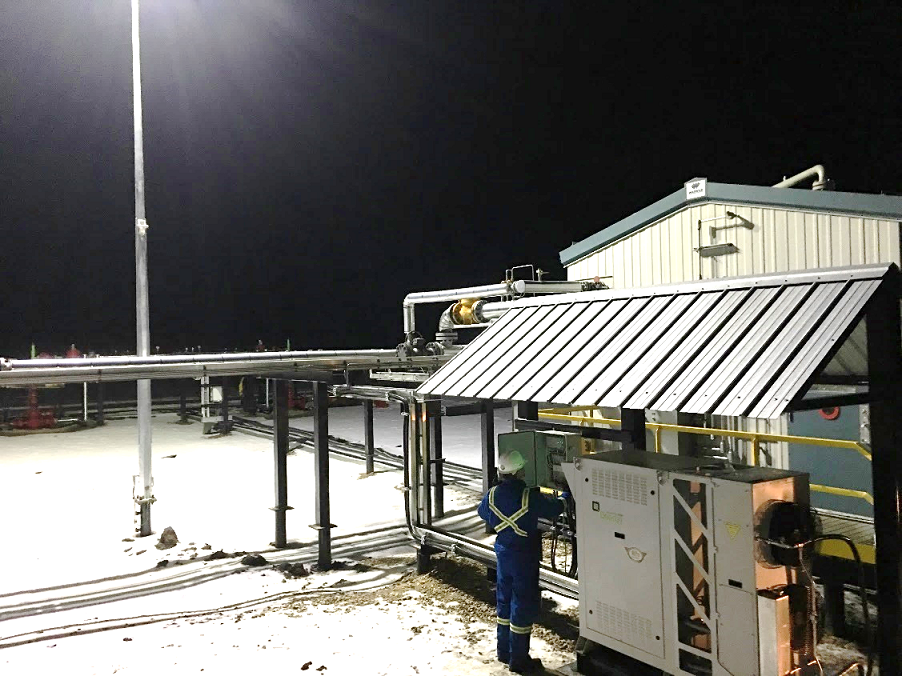

OilPro Oilfield Production Equipment Ltd.
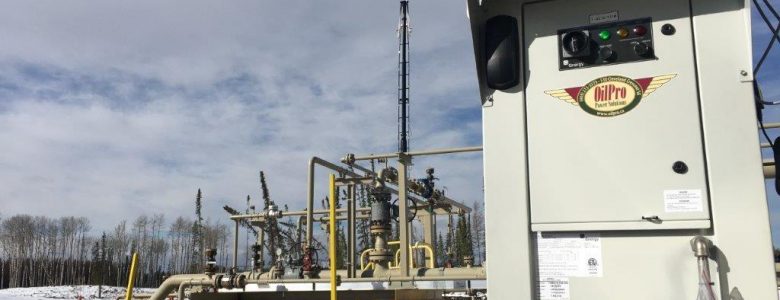
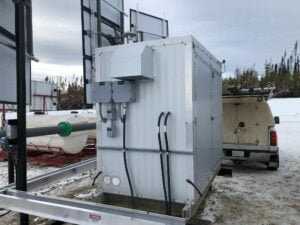 SOLARIS: Scalable solar hybrid power for electrified facilities with onboard genset for occasional heat tracing.[/caption]
SOLARIS: Scalable solar hybrid power for electrified facilities with onboard genset for occasional heat tracing.[/caption]
The Qnergy systems are now sold factory direct. For immediate assistance, call +1.801.413.7668, or contact [email protected]
Our Northern Canadian PowerGen customers continue to be supported in the field by CDN, which has factory trained Qnergy technicians, stocks common Qnergy spare parts which their technicians can install on short notice for field emergencies. Fabrication shop integration with customer power infrastructure is often done by the experienced technicians at PTW.
The indexed topic list below will still be helpful to our existing customer base for quick answers to integrating the PowerGen systems. Note this information will not be updated after October 8, 2023.
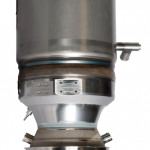 Qnergy (q-ner–gy) is the world’s leading clean technology manufacturer of Stirling energy systems, designing and manufacturing the PowerGen stand-alone power generator. We operate in the stationary power sector providing primary and back-up power as well as combined heat and power in the 1-10kW range. Our products provide low-maintenance power solutions that work reliably with a broad range of heat sources. Our generators contain proprietary Free Piston Stirling Engines (FPSE), an external combustion system. These engines are enclosed, frictionless systems that require no lubrication or repair and are capable of delivering tens of thousands of hours of uninterrupted operation
Qnergy (q-ner–gy) is the world’s leading clean technology manufacturer of Stirling energy systems, designing and manufacturing the PowerGen stand-alone power generator. We operate in the stationary power sector providing primary and back-up power as well as combined heat and power in the 1-10kW range. Our products provide low-maintenance power solutions that work reliably with a broad range of heat sources. Our generators contain proprietary Free Piston Stirling Engines (FPSE), an external combustion system. These engines are enclosed, frictionless systems that require no lubrication or repair and are capable of delivering tens of thousands of hours of uninterrupted operation
"We have 4 units in field running to date and 3 more within the next month.....The operations team can’t say enough good things about these packages as the runtime is fantastic thanks to Qnergy and OilPro."
PowerGen systems make an immediate economic case. In Canada systems and integrated systems like CAP3 qualify for carbon credits.

Available in 1800/5650Watt configurations
Designed for rugged and remote operation, the PowerGen remote power generator provides reliable electrical power supply to the most demanding and mission-critical loads. Based on Qnergy’s no-maintenance and highly reliable PCK series Stirling engines, the generator package works seamlessly with a variety of fuel supplies, including:
System Output Power
See Configuration
Power Max Gauge Wire Interface
6-20 AWG
Cable Gland Input
3/4" Std
Ignition/Standby Battery (std)
Sealed AGM Deep Cycle, 12VDC 40Ah
Battery Capacity option
up to 160 Ah for extended autonomy to facilitate on-off operations
NOTE: Standard battery supplied is 40 Ah. Float Charge is 13.65V and 0.25 A
Safety
E-stop (normally closed)
Fuel Type
Dry untreated natural gas from wellhead
Propane, C1-C4
Burner
pre-mix
Ignition
direct
Gas regulator
2-stage
Gas pressure monitor
transducer
Fuel port
1/2" NPT male
Cooling system type
Closed loop
Pump type
high efficiency Grundfos® circulating pump
Cooling fan type
EC fan (2, operating sequentially)
Coolant type required
Prestone Cor-Guard or equivalent
Coolant ratio (OilPro std Canada)
60% glycol/40% water
Max coolant volume
4.2 gal / 8.32 litre
Ethernet
RJ 45
Protocol
Modbus RTU
Internet infrastructure
TCP/IP
Remote Data Viewer
Qnergy SmartView®
Discrete I.O's
configurable
Inputs (dry contact)
x6 (16-20 AWG)
Outputs (relay)
x8 (16-20 AWG) (max 250V/1A)
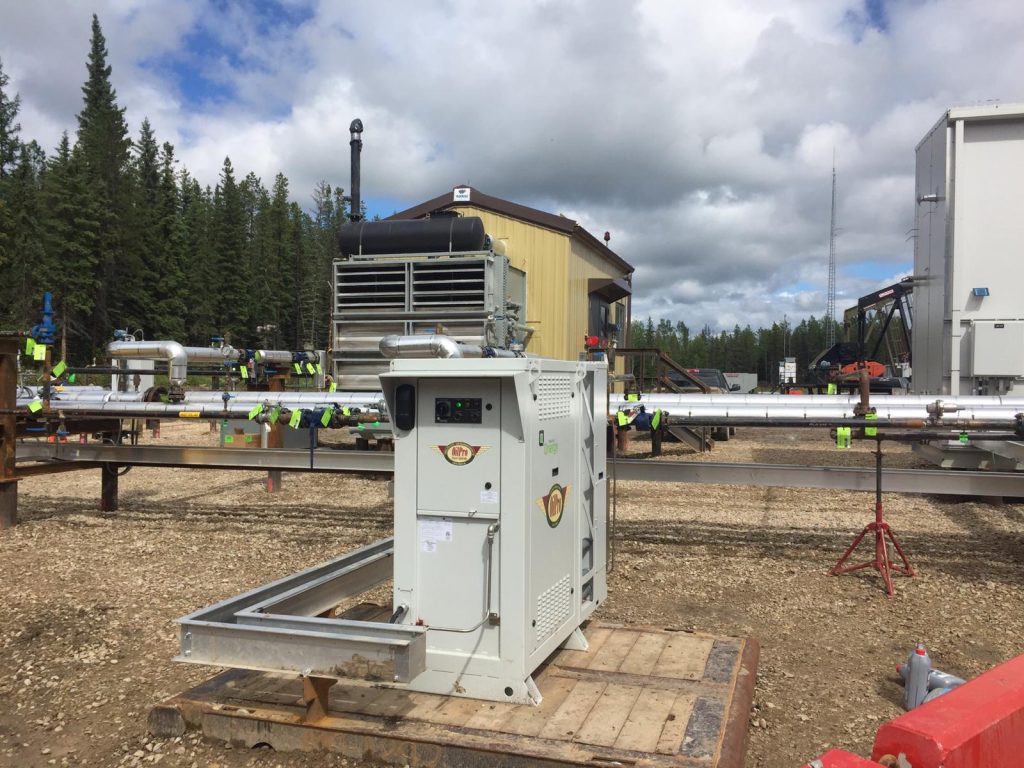
Available in each PowerGen, 1800/5650 Watt Max Power @ 85°F / 120°F: 5.65kW / 5.1kW. Note: Qnergy no longer supports the 600 and 1200 models.
| Series | configuration | phase angle | connection |
| A Standard |
120V/240VAC |
A: 0° B: 180° |
3 Wire: L1, L2 & Common/Neut. |
Additional Configurations Available |
|||
| B |
120VAC SYNC |
A: 0° B: 0° |
3 wire: L1, L2 & |
| D |
120V/240VAC 2 Phase |
A: 0° |
3 wire: L1, L2 & |
| E |
240VAC SYNC |
A: 0° B: 0° |
3 wire: L1, L2 & |
| F |
+365VDC /-365VDC |
A: 0° B: 180° |
3 Wire: +ve, L2 & Common |
| G |
+365VDC /120VAC |
A: 0° B: 0° |
3 Wire: +ve, L2 & Common |
| H |
+365VDC /240VAC |
A: 0° |
3 Wire: +ve, L2 & Common |
|
Emissions |
||
| NOx @5% O2 | 30.0 ppm | 66 mg/kWh |
| COx @5% O2 | 45.0 ppm | 60 mg/kWh |
| VOC | -- | Negligible, lean combustion |
HRU (Heat Rejection Unit) Operational Specifications |
||
| Thermal Heat Rejection |
maximum available |
x2.5-3.5 of Electric Power Output equivalent |
This code is for the field approval of gas appliances in Canada and specifically states it does not apply for "a new appliance for which there is an approved Standard".
PowerGen units offered by OilPro comply to this approved Standard.
The Qnergy PowerGen carries the ETL list mark which indicates it was tested by Intertek and found in compliance with accepted national standards including Certifications to CSA STD C22.2 NOS. 14 and 100.
Special field inspection is NOT required for PowerGen operation in Canada.
In Alberta, Gas Safety Information Bulletin G-02-01a lists Intertek Testing Services Ltd. as a nationally recognized certification and inspection body with respect to the Safety Codes Act. The Bulletin also states that a special inspection is not intended to be used as a means to accept appliances and equipment when certified products are available.
in BC, Technical Safety BC recognizes the ETL list mark as an approved certification mark for gas appliances in Directive No.: D-G5 051201 2
PowerGen ships in a carefully designed, export-quality shipping crate which easily fits in a long bed HD pickup truck or on a light flatbed trailer.
The Glycol Heat Trace (GHT) feature collects waste heat from the Stirling engine cooling system and its exhaust for uses like heating fuel lines, tanks or other components.
A plate heat exchanger separates engine coolant from the GHT medium. The GHT glycol circulates using a rotary vane pump on a variable speed motor. The PowerGen monitors the supply and return temperatures of the GHT media and adjusts operation to match the heat load and meet the return temperature set point. The GHT feature can be disabled with the winter/summer toggle switch.
| GHT Module Specifications: | Imperial/metric |
| Minimum Return Setpoint Temperature | 77 F/ 25 C |
| Maximum Return Setpoint Temperature | 131 F / 55 C |
| Maximum 1/2" tube length | 1500 ft / 457.2 m |
| Flow Rate |
0.5-2.2 gpm / 1.89-8.33 lpm |
| Fluid Reservoir - working volume | 1.5 gal / 5.68 litres |
| Fluid Reservoir - expansion volume | 0.5 gal / 1.89 litres |
| Heat Trace Interface | 1/2" NPT female |
| Coolant Filter |
100 mesh SS / 100 micron |
| Glycol Content Range | 50-60% |
We recommend Prestone CorGuard glycol 60/40 coolant for optimal performance in the primary circuit, and uninhibited 60/40 ethylene glycol in the GHT circuit for optimal systems reliability.
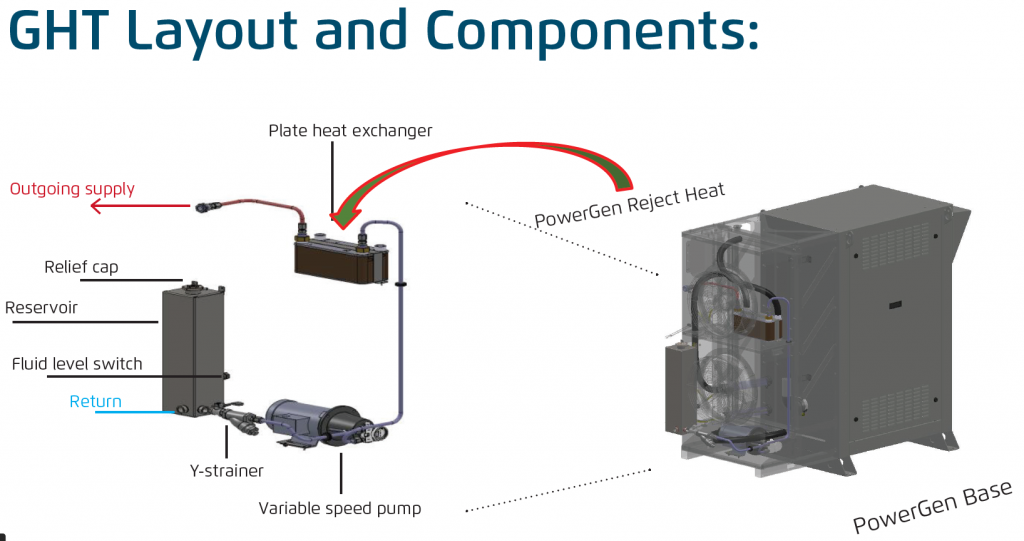
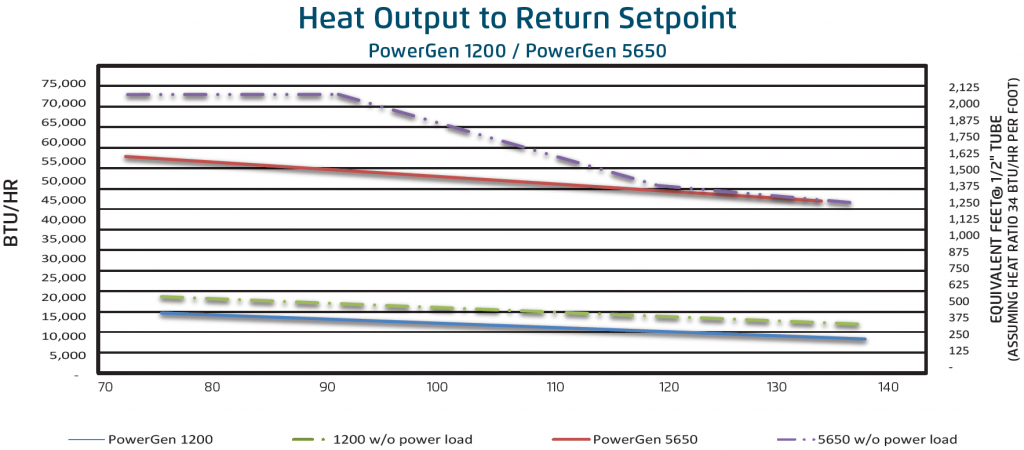
Pneumatic devices powered by pressurized natural gas are widely used in the natural gas industry for process control and chemical injection. These devices vent spent gas directly into the air threatening the clean fuel advantages of natural gas. Qnergy’s innovative low-maintenance CAP3 solution efficiently combusts the normally vented methane, while economically providing reliable electric power and clean, dry instrument air.
Off-grid options available with both CAP3F & M
For a deeper understanding, download the CAaaS whitepaper
Qnergy’s solar hybrid system leverages the PowerGen Stirling engine to supplement photovoltaic power creating the most reliable off-grid power system.
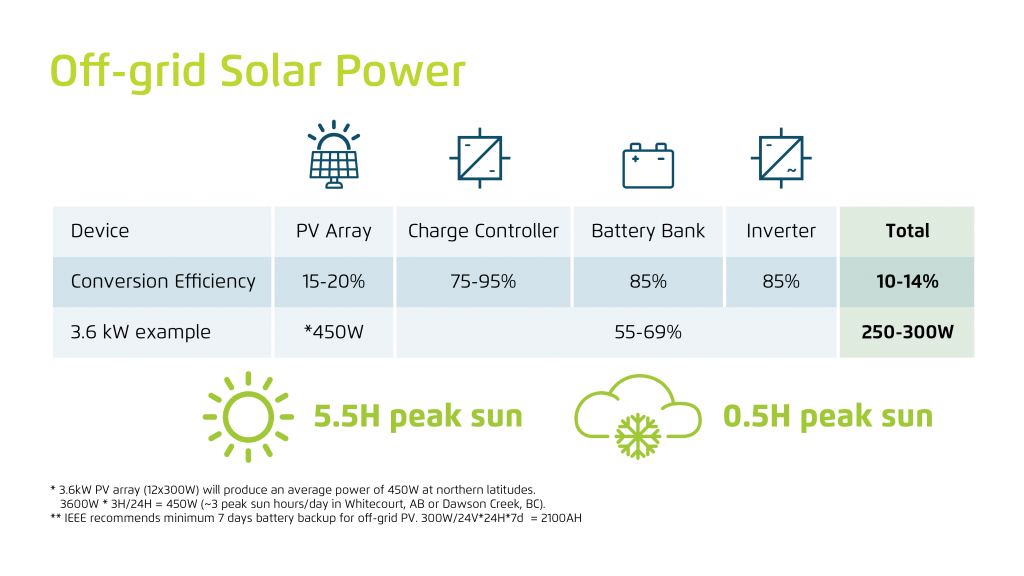
Under normal conditions, the PV array supplies power through the system’s battery bank. The PowerGen engine sits in standby, monitoring the battery health. In extended durations of poor solar availability, the PowerGen intelligent control system will start the engine and charge the batteries. In cold northern climates, the waste heat of the PowerGen system is harvested to maximize system performance to:
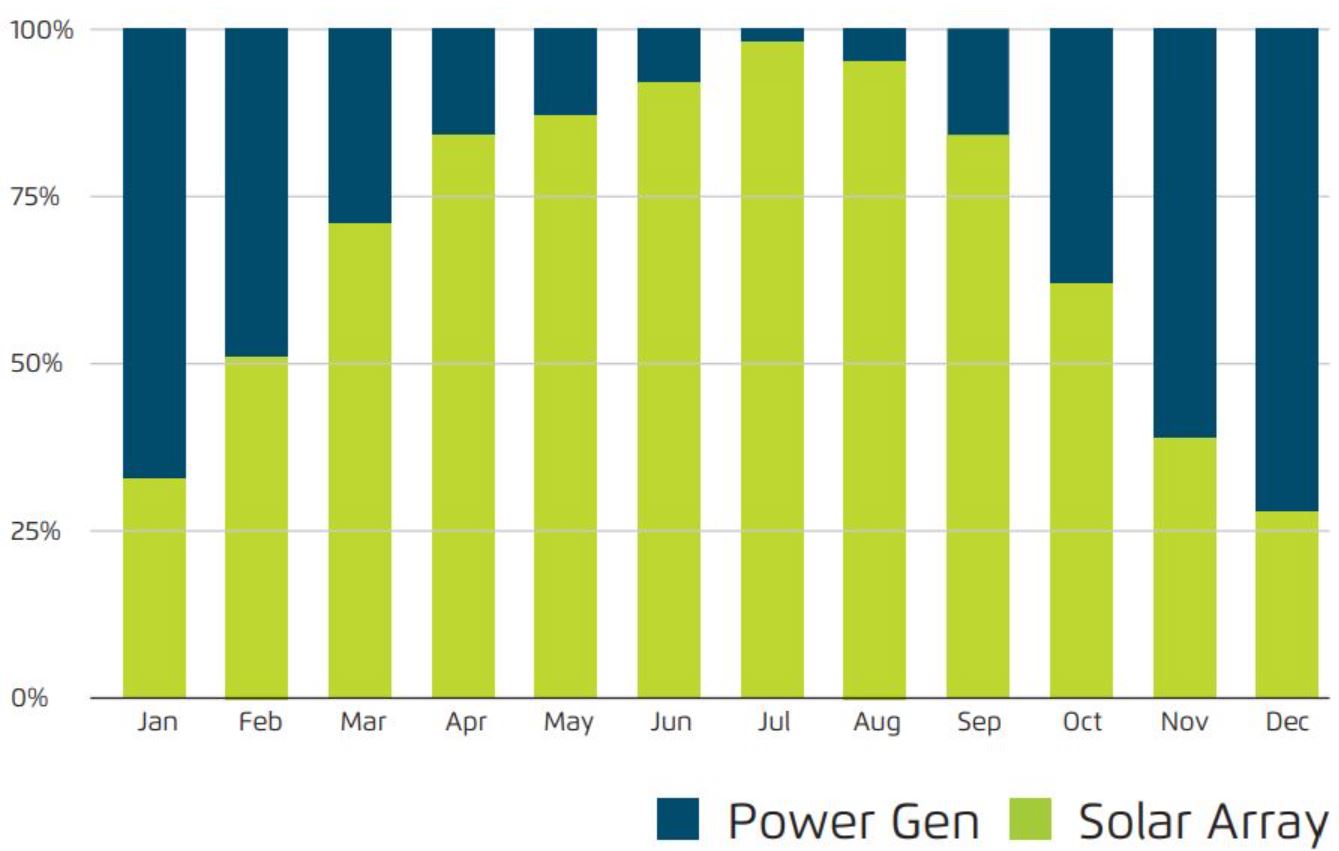
Q:How does PowerGen fuel consumption compare to traditional remote power sources?
A:Q: Why is PowerGen fuel use lower than traditional remote power sources?
A: Fuel use. A 1200 Watt Powergen consumes approximately 1/3 the amount (fewer than 27 liters) of propane than a 500 Watt TEG, which uses about 76 liters (20 Gal/day). This improves costs at installations reliant on propane supply such as telecommunications and signals etc. (PowerGens now come in 600, 1200, 1800 and 5650 W sizes)
B: Recoverable heat on glycol systems can be used to keep enclosures with electronics and batteries in a more efficient temperature range (15°C). We supply 2.5 -3.5x equivalent energy with the Glycol Heat Trace System (GHT) as heat, so for the PowerGen 5650, 14,125-19,775 Watts (48,197- 67,475 BTU/hr) of heat is available to your installation. (All PowerGens except the 600 Watt model are available with the GHT option)
C: Less supporting infrastructure required. Lower propane use and reduced spare battery capacity requirements (PowerGens will float-charge a smaller bank nicely for longer battery life and greater reliability) provide accelerated project payout, improved system reliability, and decreased environmental impact.
Q: Why choose a PowerGen?
A: No Standby power required. Traditional power supplies like solar, internal combustion, chemical and TEGs can’t guarantee reliable supply/are battery-dependent; can produce harmful emissions; require custom fuels; and can’t provide the optional benefit of waste heat availability for glycol heat tracing. PowerGen’s emissions are incinerator-like due to a controlled air-assisted external combustion system. Best of all, the capability to use any gaseous fuel available at the wellhead (including up to 1,000 ppm H2S) ensures supply and reduces the carbon footprint by eliminating the need to truck in custom fuels. 
Q: Worried about fuel conditioning costs?
A: There’s no need to be when virtually every gas and oil well makes enough associated gas with energy content sufficient to run the PowerGen. Best of all, depending on caloric value, we only require between about 550-3964 SCF/d to make 600-5650 Watts of power There is no need to guess how long your fuel lasts if it’s available any time, right from the wellhead or from a propane tank. Full autonomy is yours no matter the conditions. That the colder it is, the more efficient a Stirling-type heat difference engines become.
Q: What about Micro Combined Heat and Power?
The GHT, Glycol Heat Trace loop recovers waste heat from the engine and exhaust and turns it into a programmable return temperature loop of up to 1500' for your wellsite heat tracing or heating needs. Energy is conserved and put to work to ensure reliable fuel gas availability to critical site components on the coldest days.
Q: What about fuel availability?
A: There’s no need to be when virtually every gas and oil well in Canada makes enough gas or associated gas with a BTU content we can use to run the PowerGen. Best of all, depending on BTU’s/Cu.Ft, we only require between about 1,500 -4,000 Cu.Ft/ day to provide up to 5,650 Watts of power. There is no need to guess how long your fuel lasts if it’s available any time, right there at the wellhead or from a Propane pig or bullet. Full autonomy is yours no matter what the conditions, and remember that the colder it gets the more efficient a heat difference engine like the PowerGen’s becomes.
Q: Where do I use the PowerGen?
A: PowerGen is designed to make your existing renewables reliable, or to replace diesel generators, Solar, ThermoElectric Generators (TEGs) and fuel cells. Use it anywhere you need power and heat, close to the grid or far away from it. At service needs of 1-2 hrs/year, the PowerGen can be maintained and kept running anywhere power is critical to operations and communications.
Q. Can remote start/stop be done via communication?
A: Yes, using Modbus TCP you have extensive control and monitoring of the PowerGen. TA discrete input starts and stops the PowerGen.
Q: Do I require an additional FEB board?
A: The Front End Board (FEB) is standard on the PowerGen and includes a number of discreet IO's for customer use. The FEB has terminals for field termination.
Q: Can PowerGen and the CAP3 systems be monitored?
A: PowerGens are connected to the factory to relay its own operating parameters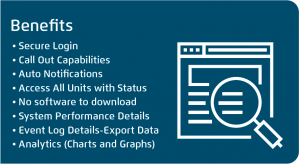 only. However it’s also fitted with Modbus capabilities for SCADA connectivity to your existing system. We provide monitoring. Qnergy, PowerGen’s parent company is well-versed in remote operations as is evident from its involvement with a number of NASA’s Mars missions.
only. However it’s also fitted with Modbus capabilities for SCADA connectivity to your existing system. We provide monitoring. Qnergy, PowerGen’s parent company is well-versed in remote operations as is evident from its involvement with a number of NASA’s Mars missions.
Furthermore, the newest generation of CAP3 systems now come with integrated, GHG emissions mitigation reporting directly to your desktop with 24/7/365 access. PowerGen and CAP Modbus registers can be read from the PowerGen IP.
Q How does the PowerGen integrate with existing UPS systems?
A:The PowerGen gives the ability to get more out of all existing battery systems due to its ability to float charge, significantly increasing battery life and allowing relatively smaller battery banks to provide more reliable power.
12VDC start battery: We can provide a system to monitor this battery system and turn on the PowerGen when it gets low (mounted in PowerGen), OR Customers can trickle charge this battery from their system, OR We can supply a small solar panel on top the PowerGen to trickle charge our start battery.
Generator start: We can provide a system to monitor a battery bank and turn on the PowerGen when a solar system can’t keep up. We can mount this in an outdoor rated panel. (Please let us know if you requrie CSA certification).We are familiar with most existing hardware, and can advise on AGS (Auto Generator Start) integration.
Q: What about cost?
A: A hardware store genset seems cheaper, but when it comes to continuously reliable critical power there is no equal in the 300 to 11,000 Watt range. Know that PowerGens have the lowest cost/Watt of any competing remote critical power system. Combine that with the additional heat recovery and proven trouble-free extra low temperature operation capability and PowerGen can't be beat. (no more frozen fuel gas systems with GHT, no more impossible starts in -40 temperatures, no more TEG condensation buildup and no more fuel cell core replacements. (There is a reason fuel cell systems are hybrid systems!)
Q: Will OilPro integrate the PowerGen with my site-specific needs?
A: OilPro specializes in coordinating Engineering, Project Management and Construction of skid packages which can include everything from rectifiers to instrument air to battery charging, straight site power, sweetening systems, gas compression, chemical pumps and heat distribution for tanks or flowlines etc. to integration with on-site fuel supply and MCC buildings and other production equipment. A general area classification provides lots of leeway in terms of site placement. OilPro takes a brand-agnostic approach to whatever requires power at your site. We will integrate PowerGen with any Qnergy vetted inverter, charger, compressor, pump, motor or electrical system you require. Once a Site Survey is done, we can coordinate with your preferred integrator or be your one-stop general contractor, whichever suits your project business model best.
Q: Can PowerGen be trailered, boxed, or otherwise housed?
A: A suitable trailer can support the roughly 1,200 lb PowerGen nicely to provide steadfast off-grid power for mobile applications from site monitoring, lights, data gathering and general communications. However mounting on concrete, piles or rig mats is also easily accomplished, as is integration on a more elaborate skid. As PowerGen’s cabinet is designed to be placed outside already there is no need to enclose it again. The -20°C versions can be partially enclosed if desired, leaving the radiator portion outside the building while contributing to heat inside the building if desired. The -40°C version of the PowerGen can provide 1200 to 5650 Watts continuously for at least its design life of 80,000+ hrs with some test units now outlasting their own monitoring equipment with continuous runs of approximately 13 years at the time of this writing!
Q: What happens internally if the air intake was to suck in an air/gas mixture?
A: Powergen is tuned to operate lean- access fuel of around 3.5-4% O2. Adding fuel into the intake air will in turn reduce the oxygen content, causing a rise in the flame temperature until it becomes too rich, causing incomplete combustion and high levels of carbon monoxide. The Powergen monitors its engine head temperature and will lower the burner rate when the head over-heats. Therefore there is no risk to the hardware. In all cases the flame remains inside the combustion chamber and is not capable of traveling upstream beyond the quenching plate (perforated plate behind the burner deck). Burner chamber volume is sized so that the flame cannot exit and travel down the sealed exhaust ducting, therefore no exposed flame.
Supporting illustration:
Q: Can this generator as a whole ignite external flammable gases?
In other words, should you treat the PowerGen as open flame equipment, which impact its location on the site due to spacing requirements of this type of equipment?
A: The Qnergy PowerGen 5650 has an enclosed combustion chamber that is fully encapsulated within heat exchangers in such a way that there is no exposed heated surface hot enough that could cause pre-ignition to external air-borne flammable natural gas.
In terms of ingress of external air-borne gas via the exhaust system into the combustion chamber, we have a positive pressure combustion chamber which, when the unit is operating, prevents any ‘unintended’ flammable gas access to the combustion chamber.
To help you with locating the PowerGen on your site, we have further clarification from Alberta's Energy Regulator: "Given how the Sterling engine operates, with an enclosed combustion chamber and no possible way for a flame front to exit the unit if an air/gas mixture is drawn in, I conclude that it operates more like an internal combustion engine rather than flame type equipment." (June 25, 2018)
Q: The PowerGen is capable of burning sour fuel gas with up to 1,000 ppm H2S; Will we be required to do dispersion modelling?
A: Section 7.12(1) of (Alberta Energy Regulator) AER Directive 060 requires dispersion modelling if the H2S content is greater than or equal to 10 mol/kmol (your 1000 ppm would be 1 mol/kmol) or one tonne per day. PowerGen doesn’t trigger either of these, so dispersion modelling would not be required by Directive 060.
Note that our free-standing height is only 54 inches, so it would be possible for the emissions to be very undispersed if someone was standing nearby. OilPro recommends consideration is given to determine whether the operator might want some sort of setback distance so that a person couldn’t stand too close to the exhaust.
The heat of the exhaust will provide some lift and may act like an effective stack height, taking the plume up into the air, to then disperse more as it travels downwind. The Air Quality Objective for SO2 is 172 ppb, so the dispersion would need to be taken from the original concentration of about 1,000,000 ppb (1,000 ppm) resulting from the original 1,000 ppm of H2S, down to 172 ppb. Dispersion is quite effective, so this is probably not difficult to achieve (comparatively much larger sources still dilute to levels below 172 ppb), but if required it is recommended to model the scenario to be sure of each case.
Bottom line: no, AER requirements do not require a model of the gas stream of this low H2S concentration and rate.
Q: What makes the Free Piston Sterling Engine (FPSE) last so long without maintenance?
A: This in-depth version, explains NASA’s experiment with the FPSE running continuously since 2003.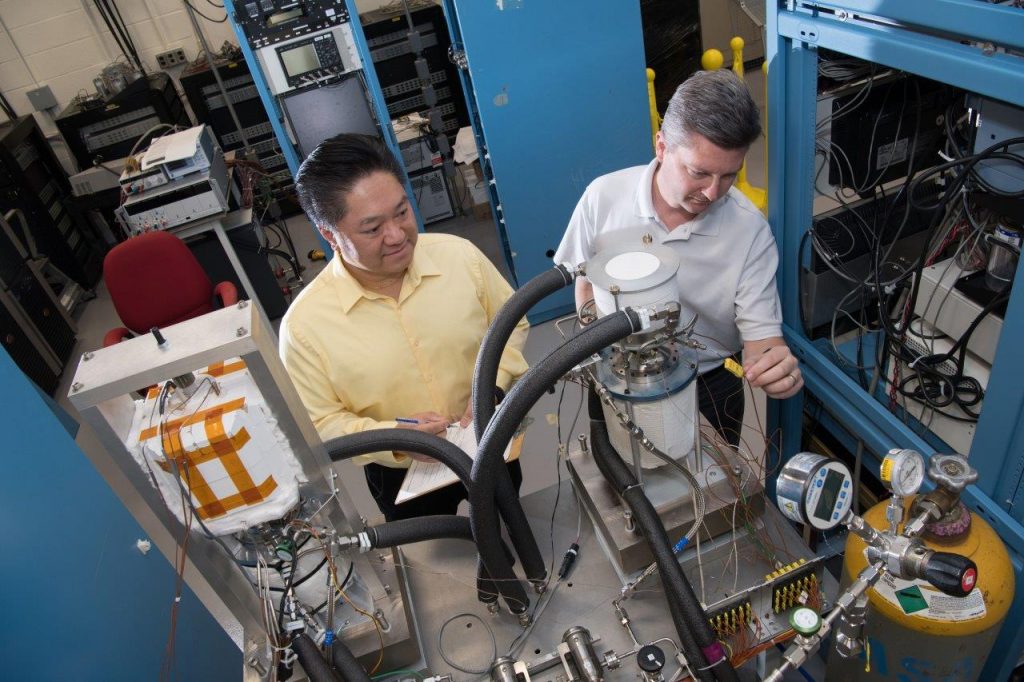
In brief: The FPSE is designed to have no contact between moving parts. There are no contacting bearings or seals which eliminates wear items. Secondly the hot-end metallurgy, weld procedures and assembly methods were carefully chosen for their durability. Any engineer will tell you that the best designs are usually the simplest. The FPSE is no exception. The engine contains helium gas, which is heated at one end, and as the helium expands it forces a piston away from the hot end and into an oscillating cycle. Indirect action between this piston induces movement of a secondary piston which incorporates a linear alternator that generates electrical output. There is no rotary motion, no crank, just back and forth movement, enabled by internal springs called flexure plates, which resemble the small discs found in 45 RPM vinyl records. The flexure plates are designed around a material fatigue life beyond that of the required operating life of the engine. The engine design life is in the order of 10-20 years to match NASA’s mission durations in the 17-year range, but speculations indicate these engines can last beyond 20 years. We’ll only know for sure in 2023.
Q: Why should we consider the PowerGen a clean technology when it burns hydrocarbons?
A: This comes down to what Ory Zik, CEO of Qnergy calls “Carbon Literacy”, which involves taking into account a system’s overall lifetime carbon footprint. There are four reasons the PowerGen should be considered to have a lower carbon footprint versus alternate remote site critical power generation systems.
First is the lifetime carbon footprint. We must take into account the total lifetime carbon footprint of an engine. The FPSE was declared by NASA to be “the most reliable generation technology in history”. The FPSE requires minimal scheduled maintenance and component replacement/service. No oil changes and fewer visits to PowerGen sites mean less carbon-intensive maintenance. This is why the PowerGen compares favourably versus internal combustion engines but als compared to fuel cells, both of which require replacement of major components at regular intervals.
Second is the efficiency, either stand-alone but also in a CoGen (or Micro Combined Heat and Power or CHP) application. Consider the PowerGen’s ability to control combustion at a near-perfect stoichiometric ratio once installed, regardless of the fuel gas quality used. This means there is an extremely efficient conversion of the energy in the burned gas top electricity + heat. This is achieved with an air-assisted on-board system-powered blower adjusted to match the burner’s need for air with the BTU’s available in the fuel gas. In colder climates Co-Generation plays a role in applications where a continuously maintained process temperature is important. The PowerGen provides additional carbon footprint reductions by using its own waste heat to circulate hot glycol on site. This raises the PowerGen’s overall efficiency from the roughly 20-30%+ range into the 70-90% range. Converting energy on site using gas available on-site fuel is extremely efficient. Once one considers fuels such as gasoline, diesel or processed gas can ultimately result in an overall energy conversion rate as low 10-20% at the driven wheel after all the losses throughout the processing and distribution networks, decentralized power generation makes a lot of sense. Similar losses apply to centrally generated and distributed electricity networks, regardless of the means used to generate power, due to line losses in distribution.
Third is the reduced reliance on backup battery storage. The Powergen, due to its significant power output compared to conventional remote power sources like ThermoElectric Generators (which, like the FPSE are a very reliable form of heat engine, but only due to their relatively short conductive path, end up converting only 6% of that heat into electricity) and fuel cells (Which can be both fuel dependent and have a limited, expensive, key component lifespan), means fewer backup batteries are required because the PowerGen can help recover drained onsite energy storage more quickly. As the charge rate is much higher, lower reserves are required. Solar and wind power require even more battery backup due to their intermittent and seasonally variable nature. We all know that our car batteries eventually die, with a typical lifespan of 2-5 years. Reducing the amount of required backup power causes a significant reduction in the carbon footprint of the overall system PowerGen is part of. PowerGen customers are also using the Glycol Heat Trace (GHT) option to keep batteries within their most efficient temperature range, further extending battery life and reducing the need for additional backup in low temperature operations.
Fourth is that the PowerGen shines at times when everything else on a site starts to fail. The PowerGen becomes more efficient the colder the ambient temperatures are, which happens to coincide with PowerGen customer’s greatest reliance on continued operation of their facilities. During the prolonged cold spell of the 2019 Polar Vortex which saw temperatures dip into the -40°C bracket, OilPro’s PowerGen customers reported how pleased they are that many cold-related site visits related to freeze-up problems were eliminated due to the system’s increased reliability. Fewer emergency shut-downs mean fewer unscheduled site visits, which means fewer hydrocarbons burned calling in men, trucks, steaming equipment for unscheduled visits.



PowerGen 1800
Output Config A:120/240 VAC (25A)
Includes:
Qnergy PowerGen Unit - 1,800 watts
Output Configuration:
120/240 VAC Split Phase
Output A: 240 VAC/60 Hz
Output B: […]
